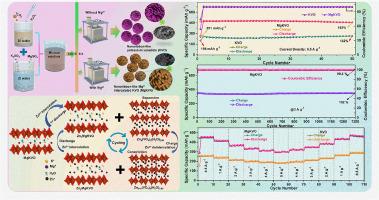当前位置:
X-MOL 学术
›
J. Magnes. Alloys
›
论文详情
Our official English website, www.x-mol.net, welcomes your
feedback! (Note: you will need to create a separate account there.)
Structural engineering of potassium vanadate cathode by pre-intercalated Mg2+ for high-performance and durable rechargeable aqueous zinc-ion batteries
Journal of Magnesium and Alloys ( IF 15.8 ) Pub Date : 2024-09-26 , DOI: 10.1016/j.jma.2024.08.018 Ashok Kumar Kakarla, Hari Bandi, Wasim Akram Syed, R. Shanthappa, Jae Su Yu
Journal of Magnesium and Alloys ( IF 15.8 ) Pub Date : 2024-09-26 , DOI: 10.1016/j.jma.2024.08.018 Ashok Kumar Kakarla, Hari Bandi, Wasim Akram Syed, R. Shanthappa, Jae Su Yu

|
Aqueous zinc (Zn)-ion batteries (AZIBs) have the potential to be used in massive energy storage owing to their low cost, eco-friendliness, safety, and good energy density. Significant research has been focused on enhancing the performance of AZIBs, but challenges persist. Vanadium-based oxides, known for their large interlayer spacing, are promising cathode materials. In this report, we synthesize Mg2+ -intercalated potassium vanadate (KVO) (MgKVO) via a single-step hydrothermal method and achieve a 12.2 Å interlayer spacing. Mg2+ intercalation enhances the KVO performance, providing wide channels for Zn2+ , which results in high capacity and ion diffusion. The combined action of K+ and Mg2+ intercalation enhances the electrical conductivity of MgKVO. This structural design endows MgKVO with excellent electrochemical performance. The AZIB with the MgKVO cathode delivers a high capacity of 457 mAh g-1 at 0.5 A g-1 , excellent rate performance of 298 mAh g-1 at 5 A g-1 , and outstanding cycling stability of 102% over 1300 cycles at 3 A g-1 . Additionally, pseudocapacitance analysis reveals the high capacitance contribution and Zn2+ diffusion coefficient of MgKVO. Notably, ex-situ X-ray diffraction, X-ray photoelectron spectroscopy, and Raman analyses further demonstrate the Zn2+ insertion/extraction and Zn-ion storage mechanisms that occurred during cycling in the battery system. This study provides new insights into the intercalation of dual cations in vanadium oxides and offers new solutions for designing cathodes for high-capacity AZIBs.
中文翻译:

通过预插层 Mg2+ 对钒酸钾阴极进行结构工程,用于高性能和耐用的可充电水系锌离子电池
水系锌 (Zn) 离子电池 (AZIB) 由于其低成本、环保、安全和良好的能量密度,具有用于大规模储能的潜力。重要的研究一直集中在提高 AZIB 的性能上,但挑战仍然存在。钒基氧化物以其较大的层间间距而闻名,是很有前途的正极材料。在本报告中,我们通过单步水热法合成了 Mg2+-插层钒酸钾 (KVO) (MgKVO),并实现了 12.2 Å 的层间距。Mg2+ 插层增强了 KVO 性能,为 Zn2+ 提供了宽通道,从而实现高容量和离子扩散。K+ 和 Mg2+ 插层的联合作用增强了 MgKVO 的导电性。这种结构设计赋予了 MgKVO 优异的电化学性能。带有 MgKVO 阴极的 AZIB 在 0.5 A g-1 下提供 457 mAh g-1 的高容量,在 5 A g-1 下提供 298 mAh g-1 的出色倍率性能,以及在 3 A g-1 下 1300 次循环中 102% 的出色循环稳定性。此外,赝电容分析揭示了 MgKVO 的高电容贡献和 Zn2+ 扩散系数。值得注意的是,非原位 X 射线衍射、X 射线光电子能谱和拉曼分析进一步证明了电池系统中循环过程中发生的 Zn2+ 插入/提取和 Zn-离子存储机制。本研究为二元阳离子在钒氧化物中的嵌入提供了新的见解,并为设计高容量 AZIB 的阴极提供了新的解决方案。
更新日期:2024-09-26
中文翻译:

通过预插层 Mg2+ 对钒酸钾阴极进行结构工程,用于高性能和耐用的可充电水系锌离子电池
水系锌 (Zn) 离子电池 (AZIB) 由于其低成本、环保、安全和良好的能量密度,具有用于大规模储能的潜力。重要的研究一直集中在提高 AZIB 的性能上,但挑战仍然存在。钒基氧化物以其较大的层间间距而闻名,是很有前途的正极材料。在本报告中,我们通过单步水热法合成了 Mg2+-插层钒酸钾 (KVO) (MgKVO),并实现了 12.2 Å 的层间距。Mg2+ 插层增强了 KVO 性能,为 Zn2+ 提供了宽通道,从而实现高容量和离子扩散。K+ 和 Mg2+ 插层的联合作用增强了 MgKVO 的导电性。这种结构设计赋予了 MgKVO 优异的电化学性能。带有 MgKVO 阴极的 AZIB 在 0.5 A g-1 下提供 457 mAh g-1 的高容量,在 5 A g-1 下提供 298 mAh g-1 的出色倍率性能,以及在 3 A g-1 下 1300 次循环中 102% 的出色循环稳定性。此外,赝电容分析揭示了 MgKVO 的高电容贡献和 Zn2+ 扩散系数。值得注意的是,非原位 X 射线衍射、X 射线光电子能谱和拉曼分析进一步证明了电池系统中循环过程中发生的 Zn2+ 插入/提取和 Zn-离子存储机制。本研究为二元阳离子在钒氧化物中的嵌入提供了新的见解,并为设计高容量 AZIB 的阴极提供了新的解决方案。


















































 京公网安备 11010802027423号
京公网安备 11010802027423号